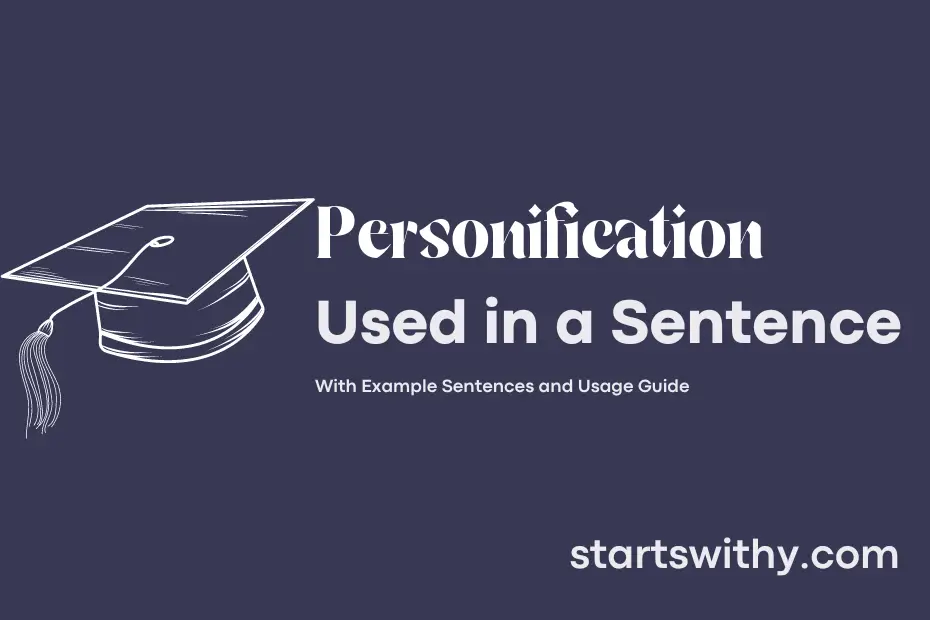Have you ever heard of the term “personification”? This literary device involves giving human traits and qualities to non-human entities or objects.
By using personification, authors bring life and vividness to their writing, allowing readers to connect with inanimate objects or abstract concepts on a deeper level.
7 Examples Of Personification Used In a Sentence For Kids
- The sun smiled down on the flowers as they bloomed.
- The wind whispered through the leaves of the trees.
- The stars twinkled like little diamonds in the night sky.
- The clouds danced across the sky, playing hide and seek with the sun.
- The moon peeked out from behind a cloud, lighting up the night.
- The rain cried gentle tears as it fell to the ground.
- The trees stood tall and strong, swaying in the breeze.
14 Sentences with Personification Examples
- The demanding deadline loomed over the students as they rushed to finish their assignments.
- The heavy burden of exams weighed down on the exhausted minds of the college students.
- The alluring call of procrastination tempted the students away from their studies.
- The exciting prospect of summer break danced tantalizingly on the horizon.
- The nagging feeling of self-doubt whispered doubt into the ears of the students before their presentations.
- The gripping fear of failure gripped the hearts of the students as they awaited their exam results.
- The bright beacon of knowledge illuminated the path for the eager learners.
- The haunting specter of peer pressure lurked in the shadows, pushing the students to conform.
- The comforting embrace of campus community welcomed the new students with open arms.
- The empowering force of collaboration enabled the students to work together towards a common goal.
- The harsh critic of self-criticism harshly judged the efforts of the students, fueling their insecurity.
- The friendly competition among classmates spurred the students to strive for excellence.
- The elusive concept of time slipped through the fingers of the students as they raced to meet deadlines.
- The dazzling allure of knowledge beckoned to the curious minds of the college students, enticing them to learn more.
How To Use Personification in Sentences?
Personification is a literary device that gives human qualities to non-human entities or objects. This technique can bring imagery to life and make descriptions more vivid and engaging. Here’s a guide on how to use personification in a sentence for beginners:
-
Identify the non-human entity: Choose an object or animal that you want to personify. It could be anything from the sun to a tree to a car.
-
Think of human traits: Consider the qualities or characteristics that humans possess. These can include emotions, actions, or sensations.
-
Create the sentence: Write a sentence where you attribute human qualities to the non-human entity. For example, “The wind whispered secrets through the trees.”
-
Use descriptive language: To enhance the effect of personification, use descriptive language that appeals to the senses. This can help readers visualize and connect with the imagery.
-
Practice makes perfect: The more you practice using personification, the more skilled you will become at creating vivid and imaginative sentences.
Remember, personification is a creative way to add depth and interest to your writing. Have fun experimenting with this literary device to bring your descriptions to life!
Conclusion
In conclusion, personification is a literary device that attributes human characteristics to non-human entities, creating vivid and engaging imagery in writing. By using personification, authors bring life and emotion to inanimate objects or abstract concepts, making them easier for readers to relate to and understand. For example, “The wind whispered through the trees” or “The sun smiled down on the children at play” exemplify how personification can enhance descriptive language and evoke powerful mental images.
Overall, personification allows writers to imbue their words with depth and creativity, enhancing the reader’s experience by making the text more colorful and engaging. This technique is widely used in literature, poetry, and everyday language to convey complex ideas in an accessible and relatable manner, making it a valuable tool for effective communication and storytelling.



